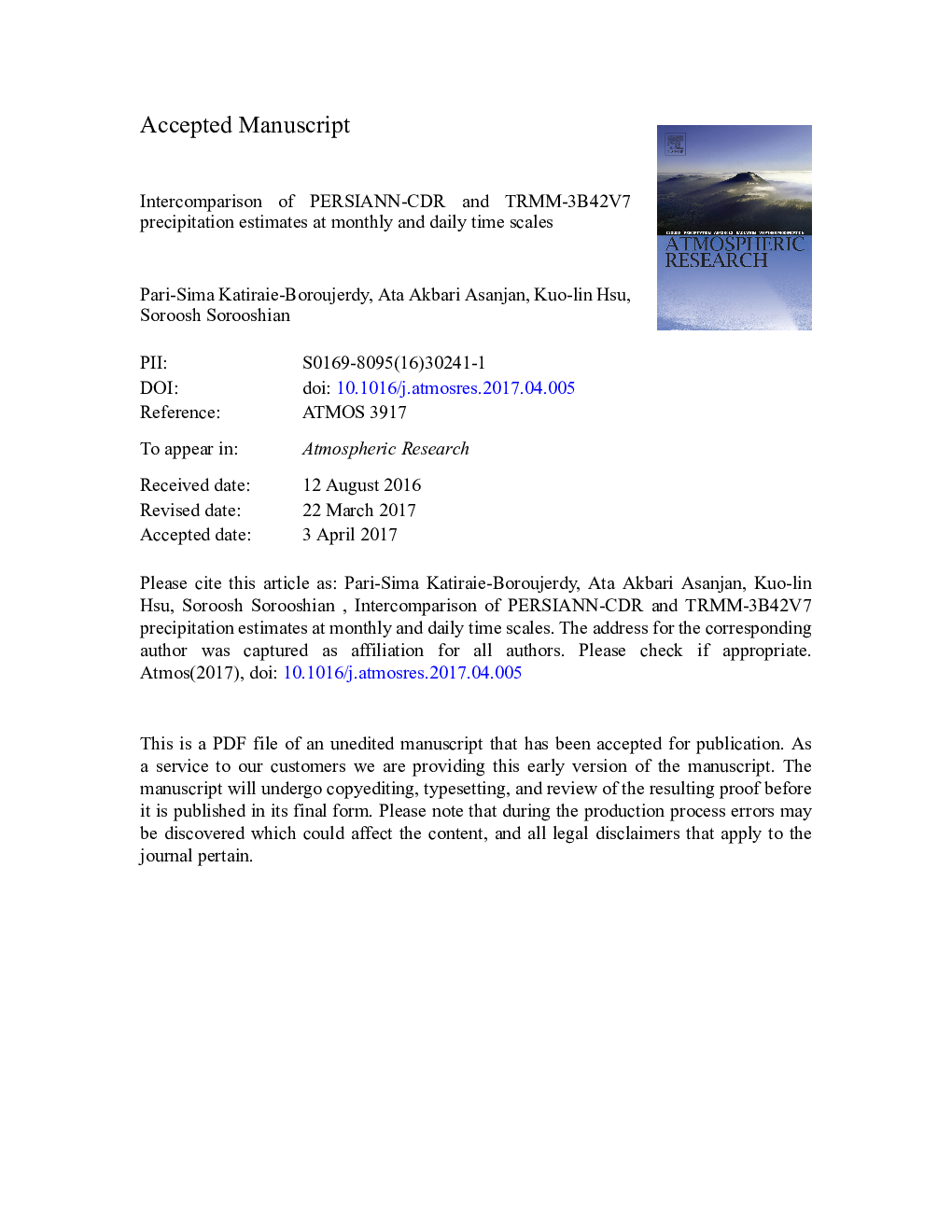| کد مقاله | کد نشریه | سال انتشار | مقاله انگلیسی | نسخه تمام متن |
|---|---|---|---|---|
| 5753635 | 1620488 | 2017 | 40 صفحه PDF | دانلود رایگان |
عنوان انگلیسی مقاله ISI
Intercomparison of PERSIANN-CDR and TRMM-3B42V7 precipitation estimates at monthly and daily time scales
دانلود مقاله + سفارش ترجمه
دانلود مقاله ISI انگلیسی
رایگان برای ایرانیان
کلمات کلیدی
موضوعات مرتبط
مهندسی و علوم پایه
علوم زمین و سیارات
علم هواشناسی
پیش نمایش صفحه اول مقاله

چکیده انگلیسی
In the first part of this paper, monthly precipitation data from Precipitation Estimation from Remotely Sensed Information using Artificial Neural Networks-Climate Data Record (PERSIANN-CDR) and Tropical Rainfall Measuring Mission 3B42 algorithm Version 7 (TRMM-3B42V7) are evaluated over Iran using the Generalized Three-Cornered Hat (GTCH) method which is self-sufficient of reference data as input. Climate Data Unit (CRU) is added to the GTCH evaluations as an independent gauge-based dataset thus, the minimum requirement of three datasets for the model is satisfied. To ensure consistency of all datasets, the two satellite products were aggregated to 0.5° spatial resolution, which is the minimum resolution of CRU. The results show that the PERSIANN-CDR has higher Signal to Noise Ratio (SNR) than TRMM-3B42V7 for the monthly rainfall estimation, especially in the northern half of the country. All datasets showed low SNR in the mountainous area of southwestern Iran, as well as the arid parts in the southeast region of the country. Additionally, in order to evaluate the efficacy of PERSIANN-CDR and TRMM-3B42V7 in capturing extreme daily-precipitation amounts, an in-situ rain-gauge dataset collected by the Islamic Republic of the Iran Meteorological Organization (IRIMO) was employed. Given the sparsity of the rain gauges, only 0.25° pixels containing three or more gauges were used for this evaluation. There were 228 such pixels where daily and extreme rainfall from PERSIANN-CDR and TRMM-3B42V7 could be compared. However, TRMM-3B42V7 overestimates most of the intensity indices (correlation coefficients; R between 0.7648-0.8311, Root Mean Square Error; RMSE between 3.29mm/day-21.2mm/5day); PERSIANN-CDR underestimates these extremes (R between 0.6349-0.7791 and RMSE between 3.59mm/day-30.56mm/5day). Both satellite products show higher correlation coefficients and lower RMSEs for the annual mean of consecutive dry spells than wet spells. The results show that TRMM-3B42V7 can capture the annual mean of the absolute indices (the number of wet days in which daily precipitation > 10 mm, 20 mm) better than PERSIANN-CDR. The results of daily evaluations show that the similarity of Empirical Cumulative Density Function (ECDF) of satellite products and IRIMO gauges daily precipitation, as well as dry spells with different thresholds in some selected pixels (include at least five gauges), are significant. The results also indicate that ECDFs become more significant when threshold increases. In terms of regional analyses, the higher SNR of the products on monthly (based on the GTCH method) and daily evaluations (significant ECDFs) is mostly consistent.
ناشر
Database: Elsevier - ScienceDirect (ساینس دایرکت)
Journal: Atmospheric Research - Volume 193, 1 September 2017, Pages 36-49
Journal: Atmospheric Research - Volume 193, 1 September 2017, Pages 36-49
نویسندگان
Pari-Sima Katiraie-Boroujerdy, Ata Akbari Asanjan, Kuo-lin Hsu, Soroosh Sorooshian,